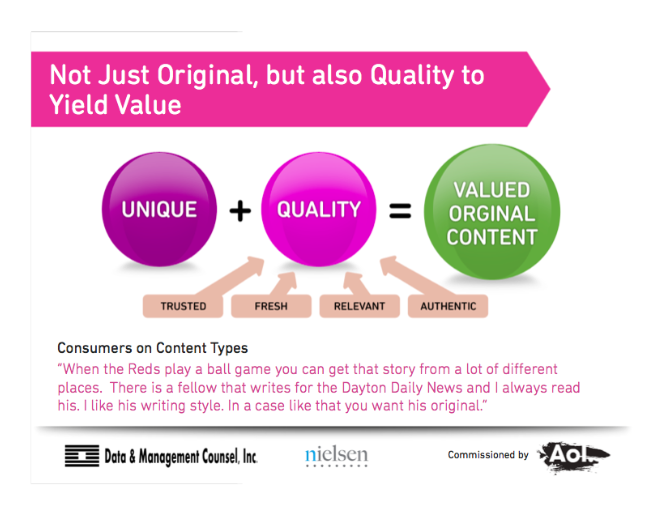Previously, I wrote an introduction to the Reciprocity Theory – my theory that brands must earn their seat in the conversation by becoming a Valued Community Member (VCM). You can read that post here. In this post, I’m going to describe how a brand can identify the types of content to produce and curate, based on the ways that audiences discover brands online, so that the brand can become a VCM.
First, let’s recap that in order to become a VCM, the individual/brand must produce or curate Valued Original Content (VOC). According to AOL’s study “CONTENT: What Drives Consumption?”, the formula for VOC is:
Unique Content + Quality (trusted, fresh, relevant, authentic) Content = Valued Original Content
Now, let’s discuss what kind of content a brand should be producing.
In its study, AOL broke down online activities into two buckets:
- Content Activities; and,
- Communication Activities
The following are my assumptions and interpretations of the infographic above:
- “Seeking/getting info” refers to search (through a search engine like Google or Bing, or within an experience such as within a news site or social network)
- “Seeking/getting info” is not mutually exclusive with “Entertainment” or “Shopping”, as the former can lead to the latter and vise versa
- “Social Networking” refers only to the act of communicating with individuals in one’s network, not the act of discovering or sharing content. The latter is reserved for “Entertainment”
Just as there are two main online activities that audiences participate in, there are two main ways for brands to be discovered by their audiences. I call these the “Discovery Points”, and they are:
- Passive Discovery; and,
- Active Discovery
Passive Discovery
Passive Discovery addresses audiences in their passive state – i.e. while they’re participating in the following activities (defined by AOL):
- Social Networking (which = 15% of online activities); and,
- Entertainment (i.e. video, games, music) (which = 16% of online activities)
It helps me to think of these as activities that you participate in while sitting back in your chair.
You enter an experience (Facebook, Twitter, your favorite news site or celebrity gossip site, etc.), and passively browse, discover and consume the content that is featured that day or in that moment.
In Passive Discovery mode, the VOC is lifestyle/interest focused.
Now say you discover something interesting, and you want to learn more about it. How are you going to discover more information or find more related content? You enter Active Discovery mode…
Active Discovery
Active Discovery addresses audiences in their active state – i.e. while they’re participating in the following activities (defined by AOL):
- Seeking / getting information (i.e. search) (which = 26% of online activities); and,
- Shopping (which = 11% of online activities)
It helps me to think of these as activities that you participate in while sitting forward in your chair.
You’re seeking specific information (more reports on an interesting piece of news or gossip, related content from a publisher you just discovered, information about a product or service that you just discovered, etc.). You actively search, discover and consume this content.
And, thus, in Active Discovery mode, the VOC is product/service focused.
It’s important to note that Passive and Active Discovery are not mutually exclusive, but rather, when coordinated properly, they create a reciprocal ecosystem of content where each guides audiences into the other, as demonstrated in the below Discovery Map.
Now, different products/services follow different purchasing frequencies. For example, you may buy a box of cereal every week, but buy a new cell phone only once every year or two, and lease a car only every three to five years. How do you conquest audiences, so that when they arrive at the “Purchase Point” (the point at which they need to purchase a product/service in your vertical), they choose your product/service over your competitors’?
You must win “Share of Voice”, “Share of Conversation” and, ultimately, “Share of Mind”.
I’ll be covering this in my next post.




